Theros limited hasn’t been around for long but it’s safe to say that it’s one of my favorite Draft formats of all time. My best explanation for this is how well the format rewards good, synergistic drafting and deck design. As much as I have enjoyed playing Standard, the decks that are viable revolve more around individually powerful cards and less around card interaction. Domri Rade + creatures and Unburial Rites + Grisly Salvage are not my idea of synergy.
With the Pro Tour right around the corner, I’ve been trying my hardest to break down and decipher all of the synergies and archetypes Theros Draft has to offer. Today I’d like to go over a few strategies I’ve had success with and what makes them tick.
U/W Heroic
Let’s start with one of my favorites. If you find yourself in a position to draft blue/white, you definitely want to get the heroic deck. Without the presence of cards like Divination, Essence Scatter or Pacifism, trying to go a more control route doesn’t really work out.
There are two keys to making this archetype work and the first is simple enough. Draft as many creatures with Heroic abilities as possible. The actual creatures themselves are much more important than the enablers, especially because most of them are uncommon. The best one at common is by far Wingsteed Rider, serving as the lynchpin for this deck. Keep in mind due to the nature of Heroic any reasonably-costed creature is worth considering because you will be running a lot of ways to power it up. For example Omenspeaker is great in this archetype; providing early defense, value from scry and a body to throw auras on when the heroes are indisposed.
The second part is a bit trickier. There are three types of heroic enablers: Bestow creatures, normal auras, and single-use tricks. The tough part is constructing the correct balance of each.
Bestow creatures are usually the safest bet. They provide great value as auras and when you don’t actually have something to bestow them onto, they can just be played as creatures. The one issue I find with them is all of the Bestow costs are rather high. You’re usually going to need enablers of the other two types to bridge the gap. For normal auras, we have a few options at common or uncommon:
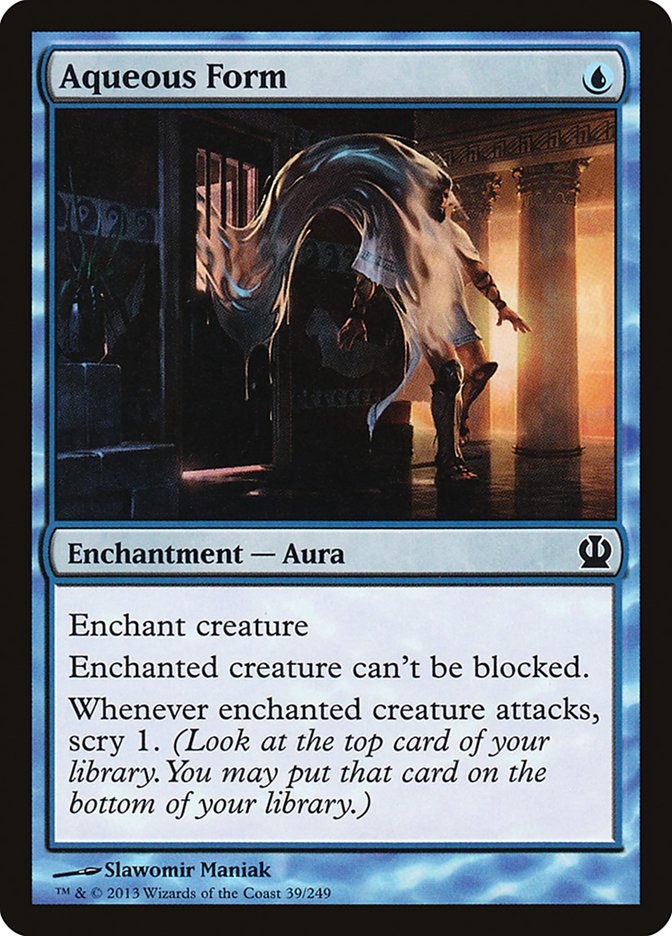
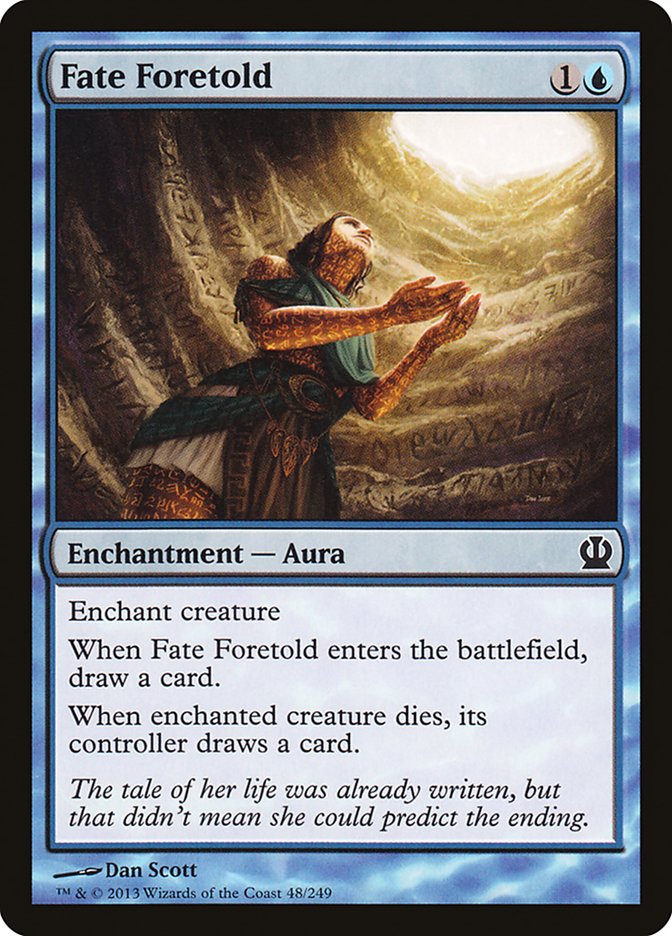
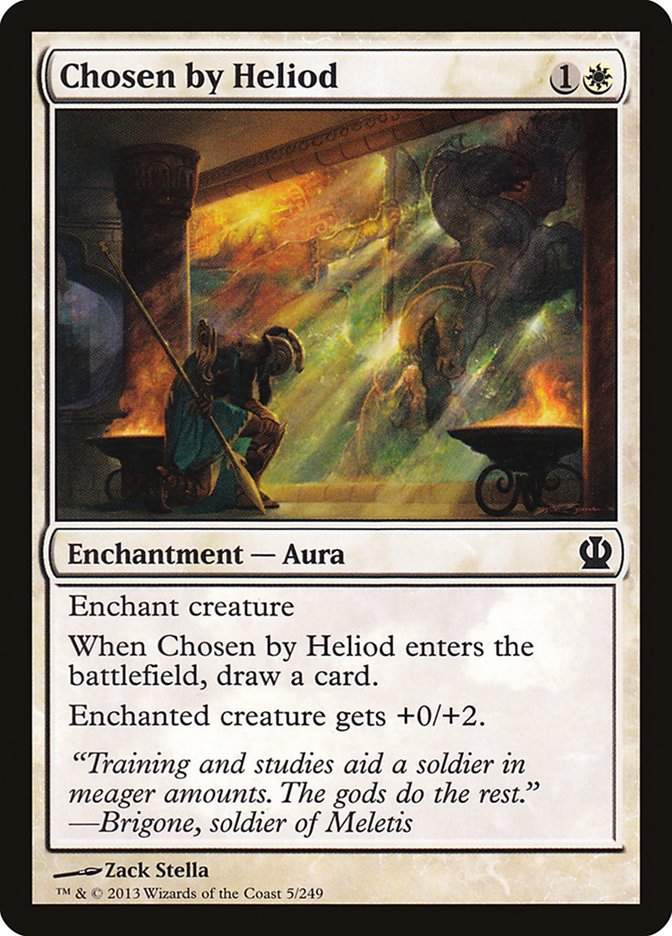
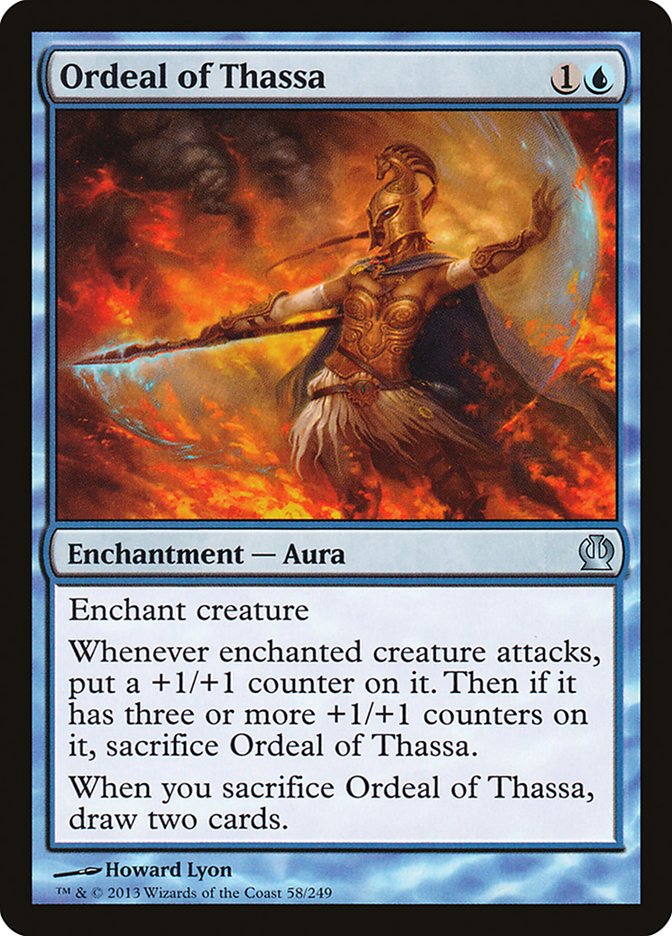
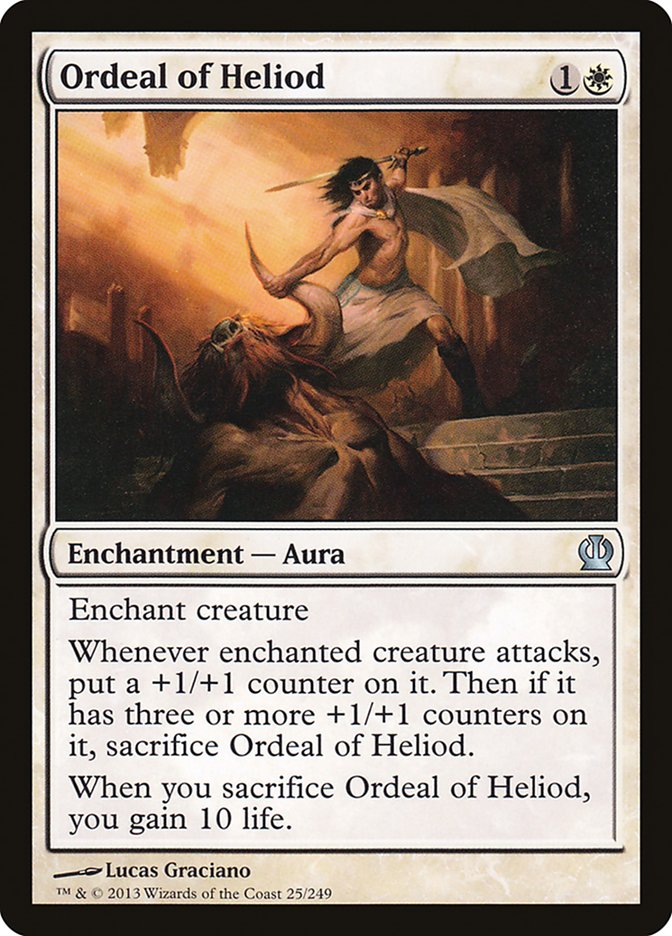
The best part about each of these is how cheap they are, costing two mana or less. Fate Foretold and Chosen by Heliod are especially alluring because they draw a card when they resolve, which helps avoid getting two-for-one’d and also digs you into more heroic triggers.
I actually have a fair amount of respect for Aqueous Form. You can’t ask for a cheaper way to trigger Heroic, and getting to scry one every turn is a Godly ability. Also when you’re building a giant enchanted beater how could you go wrong with making it unblockable? I’m not saying to jam as many of these as possible into your deck, but if you can grab a copy late in the draft it is definitely worth considering.
The ordeals are tougher to evaluate. They offer no protection and can take a while to get value. Luckily, a majority of the Heroic creatures you are working with give +1/+1 counters as part of their trigger. The ordeals don’t need to actually trigger three times to sacrifice; as long as your creature has three +1/+1 counters on it after the ordeal triggers you will be able to cash it in. Therefore all Ordeals get much more attractive once you have a few Favored Hoplites or Wingsteed Riders in the deck.
The final way available to trigger Heroic comes in the form of instants and sorceries. Depending on the structure of your deck, these are usually the worst option. Since you only get one use out of the spell you are casting, using them strictly to trigger Heroic can be wasteful. For example, if your deck is full of Wingsteed Riders, Battlewise Valor is probably not where you want to be. Sure you can use it to trigger Heroic, but since your target is evasive, you’re going to miss out on the value of pumping it in combat.
The two big exceptions to this rule are Gods Willing and Triton Tactics/Dauntless Onslaught. Gods Willing is so cheap and good at what it does that you can never be sad to have it on the team. Often you’re going to be putting all of your eggs in one basket by suiting up a single creature, which leads to two outcomes. Either it goes unopposed and you win, or your opponent tries to remove it and you blow them out with Gods Willing while getting another Heroic trigger. Without Gods Willing, though, the mage getting blown out is probably you. When it comes to Triton Tactics and Dauntless Onslaught, burning a spell has a much lower opportunity cost when you’re potentially getting two Heroic triggers out of the deal. The more actual Heroic creatures you have, the better these two get.
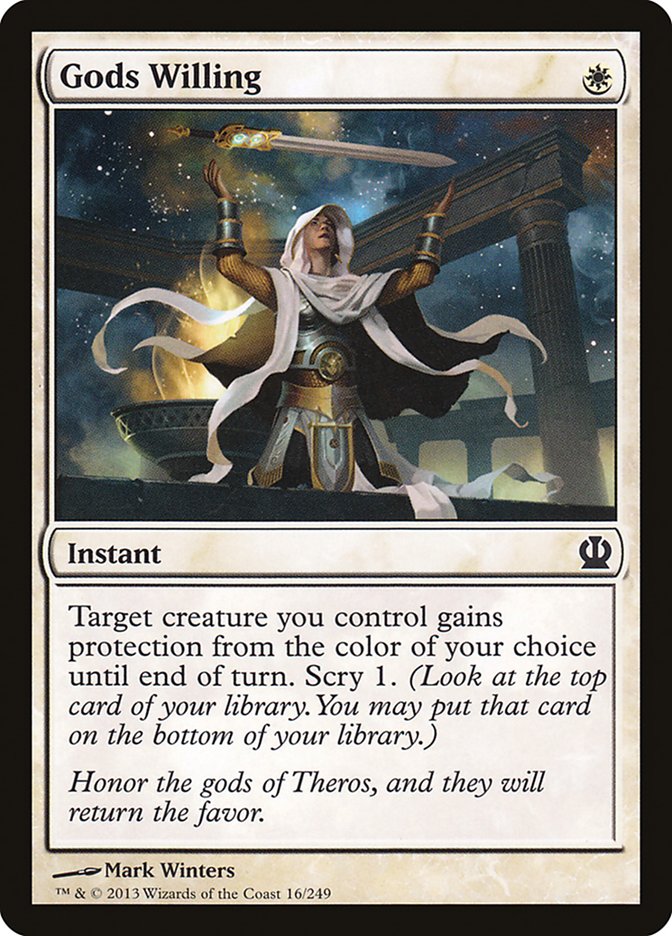
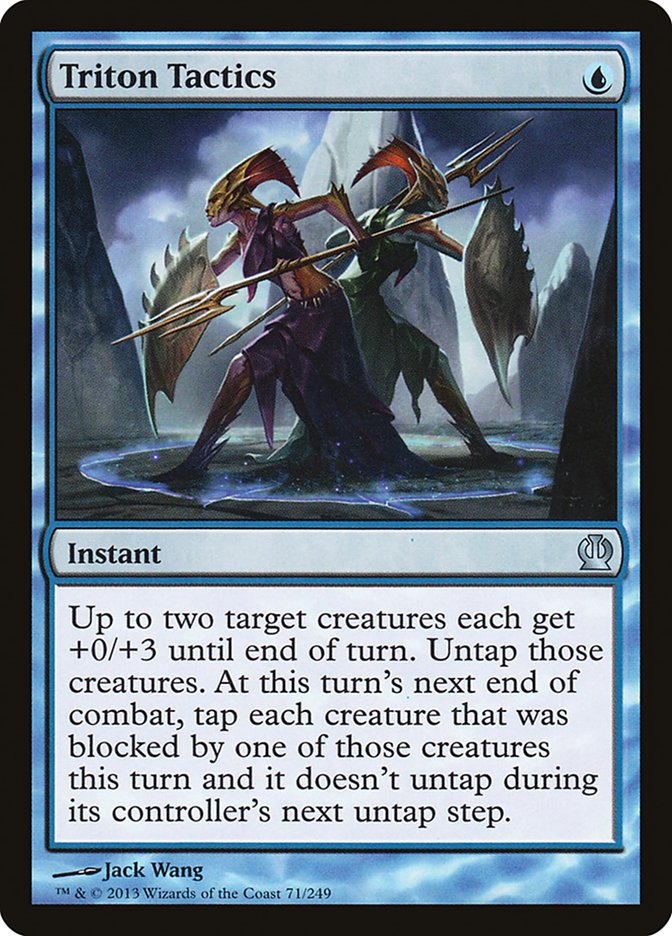
One last thing to keep in mind with this archetype is that it’s better to be base White. When your key cards are Wingsteed Rider, Favored Hoplite and Phalanx Leader, being able to favor Plains in a ten-seven manabase can make all the difference.
R/B Aggro
Last Sunday the StarCityGames.com Standard Open in Worcester took place. Although I was in attendance, I didn’t have a deck handy that I wanted to play and found myself playing in the side drafts. The first two decks I drafted were insane: blue/green with double Reverent Hunter and Bow of Nylea, and blue/white Heroic with triple Phalanx Leader and Elspeth, Sun’s Champion. I was able to easily advance to the finals with both decks but almost met my demise each time at the hands of aggressive red/black decks. Although my two decks had a much higher card quality, without a few lucky draws I would have easily been defeated.
Last week I spoke about the Minotaur version of this archetype which can be found here. Even though the tribal theme will lead to a stronger deck when you can get it, normal red/black aggressive decks are nothing to scoff at.
The most important aspect to making this deck work is getting a critical mass of two-power one- and two-mana creatures. Since your deck is going to be lacking in overall power level, playing creatures on-curve is vital. Fleshmad Steed, Tormented Hero, Arena Athlete, Deathbellow Raider, and Satyr Rambler are the non-rare options we have available to us. The only one of these I actively try to avoid is Satyr Rambler. Having trample is definitely not a good trade-off for dying to everything under the sun. For the same reason I don’t love Arena Athlete, but once you have a few Scourgemarks and Dragon Mantles handy it becomes much more reasonable.
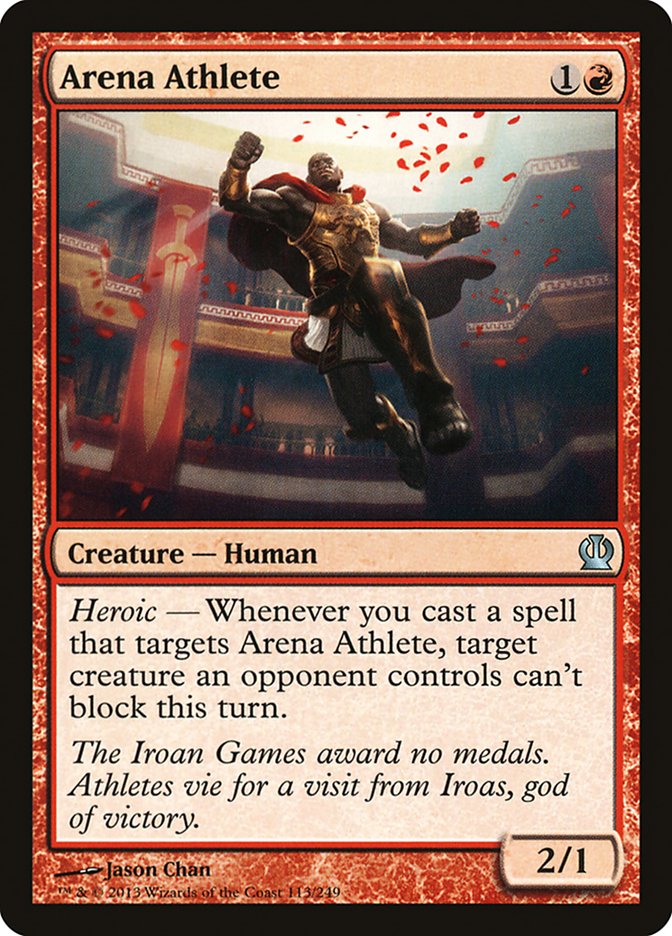
Deathbellow Raider is the best choice by far. Not only does he gain additional value when you can go tribal but having three toughness is very relevant. Dodging Pharika’s Cure and Magma Jet is a huge upside. The only two creatures that can threaten to kill it on turn two are Fleecemane Lion, a rare, and Returned Phalanx, a card only played mainboard by one color combination. Unlike the other options, it even has some value in the late game. Being able to block a monstrous creature, regenerate and threaten to swing back the turn it comes into play might be just enough to turn a race in your favor.
The other important aspect of this deck is more of a general Magic rule: know your role! Sure, Keepsake Gorgon is awesome. It may well be the best uncommon in the whole set. However, seven mana is no small order. If you’re drafting the all-in red/black aggressive deck, the Gorgon will be actively bad for you. You’re definitely not in the market for a defensive 2/5 and you’ve most likely already lost if you’re playing your seventh land. More than once now I have taken a two-drop like Deathbellow Raider over Keepsake Gorgon and gone on to win the draft. A more midrange and removal-based red/black deck is possible to be sure, and would serve as a much better home for cards like Keepsake Gorgon. In the same vein a card like Portent of Betrayal is much better than Sip of Hemlock in this style of deck.
U/B Control
While white doesn’t pair very well with blue when it comes to drafting a control deck, things are much different when it comes to black. The main reason is that black actually offers a reasonable removal suite to compliment Voyage’s End, Griptide, and Dissolve to keep creatures off the table for good. At non-rare we have Pharika’s Cure, Lash of the Whip, and Sip of Hemlock.
Of these three, each serves a different but important role. Grabbing at least one Pharika’s Cure is important to help against aggressive decks but you shouldn’t overload on it because it can easily be a blank against big green decks. The one big benefit in that color matchup is how well it lines up against Voyaging Satyr, one of green’s best cards.
Lash of the Whip is the worst of the three when it comes to efficiency, but it is a necessary evil. I really wish it either cost less or gave -5/-5. Costing five makes it almost impossible to use as a combat trick and not handling that fifth point of toughness makes it a blank against a lot of important creatures. When your five-mana removal spell can’t kill their five mana creature (Nessian Asp, I’m looking at you) you’re going to be in a rough spot.
Sip of Hemlock is also pretty expensive but at least it does its job well. Although a control deck is not really in the market for making them lose two life, this is the only non-rare card in the set that unconditionally kills a creature! As such it is essential to have one or two of these in your deck because there will be some creatures that you just have to kill that the other options won’t cover. They tend to get picked up pretty early due to the scarcity of removal, so don’t hesitate to snap them up as soon as possible.
While it’s true the removal options in black are a little lacking there are two two-mana creatures that play the role of pseudo-removal very well. The obvious one is Baleful Eidolon. Although it won’t do too much against fliers, playing it on turn two helps your chances of getting to the late game quite a bit. The other creature I’m talking about is Returned Phalanx.
A two-mana 3/3 can go a very long way towards holding off early creatures in this format. Pretty much nothing is going to be ready to profitably throw down with it until your opponent has enough mana to start Bestowing or playing giant creatures, but by then you should have had ample time to set up. Phalanx also has the secret upside of playing extremely well with my favorite card in the whole set:
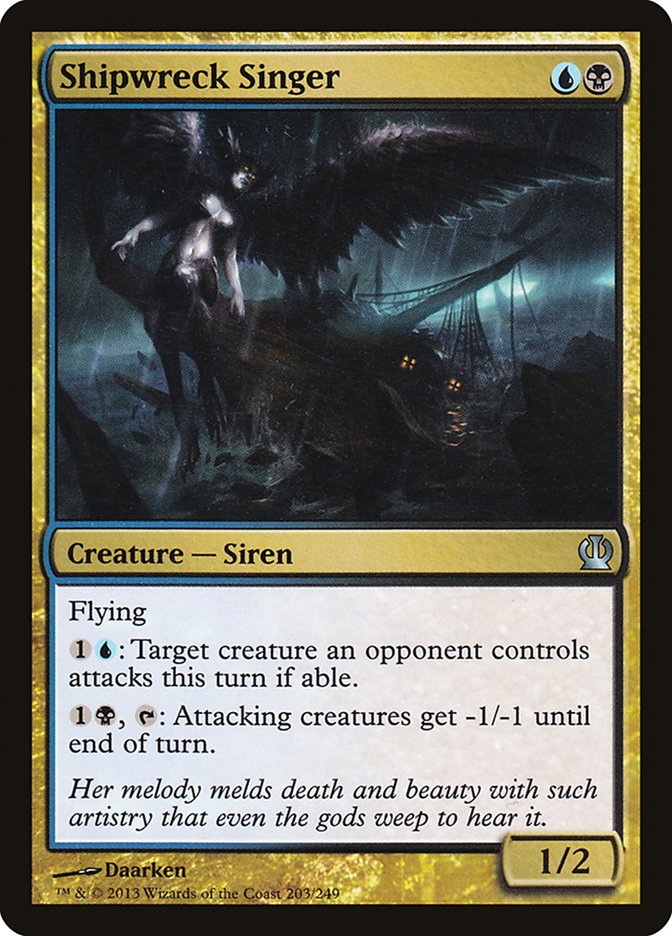
How many things can your two-mana creature do? The abilities on this siren are very powerful and synergistic just on their own. However, to truly maximize this card’s potential you need big creatures for your opponent’s creatures to run into. Utilizing this is why Goblin Diplomats was at its best when paired with green in M14 Draft. Since Shipwreck Singer already locks you into two colors, it is unlikely that you’re going to want to splash green and wreck your manabase just to accomplish this synergy. Enter the Phalanx. A 3/3 is pretty good body to run things into. This one-two punch is one of most powerful reasons to play blue/black.
Now that we have our removal and early game covered, the last two things to making a control deck tick are draw spells and win conditions. Luckily, unlike white, black offers up a good midgame card drawer in the form of Read the Bones. This card is super sweet and helps dig you to exactly what you need at any stage in the game. Keep in mind that people love scrying and they love drawing cards. Do not expect to see these go very late at all.
The other card draw spell we have access to is Thassa’s Bounty. Not going to lie, I’m not a huge fan of this one. Paying six mana at sorcery speed to draw three cards is rough especially when your opponent is either doing something very powerful on turn six or has been beating you down since turn two. When I do play Thassa’s Bounty I look at is as more of a win condition than a draw spell. If you get a deck with a ton of counters and removal, burying your opponent in card advantage and winning with tiny creatures isn’t the worst plan.
The best win condition for this deck comes in at common. I’m of course talking about Gray Merchant of Asphodel. This card is completely busted. Picking up as many of these as possible will ensure your deck has a definite way to close out games, while it also keeps you alive and provides a meaningful defensive body. He plays very well when prioritizing cards like Returned Phalanx which can get in some early damage and augment the life drain later. Because I like to use Gray Merchant of Asphodel as my main win condition in this type of deck, I put an even higher than usual priority on drafting Disciple of Phenax. Getting to strip a card from your opponents hand is already valuable, but adding two devotion to the mix increases its stock significantly.
All in all, I’m really pleased with how Theros Limited is playing out, and can’t wait to draft it on the big stage. By the time this article is up I’ll already be in Dublin with my team, gearing up for a week of testing and good times. Unfortunately I won’t have my laptop with me, so I’m going to have to miss a week of writing for you guys. Wish me luck and I’ll see you when I get back!
